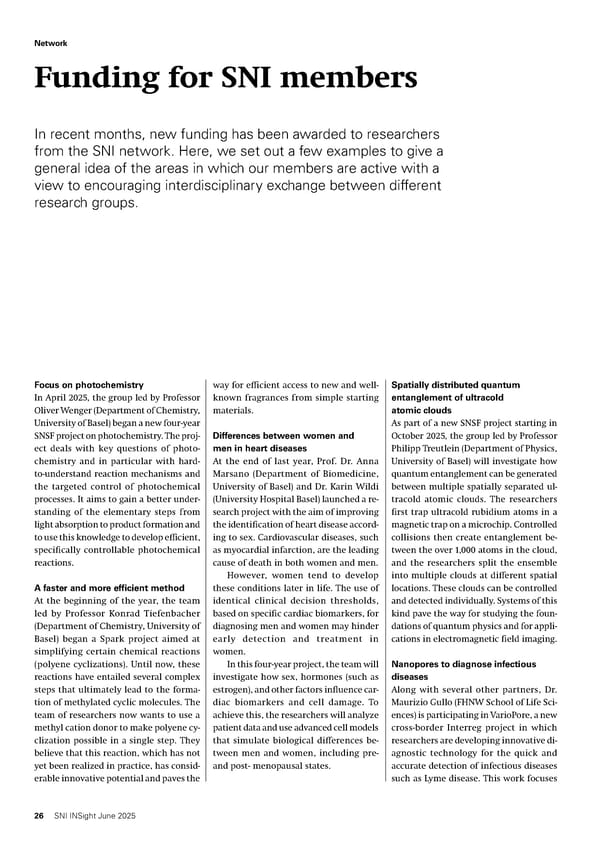Network Funding for SNI members In recent months, new funding has been awarded to researchers from the SNI network. Here, we set out a few examples to give a general idea of the areas in which our members are active with a view to encouraging interdisciplinary exchange between different research groups. Focus on photochemistry In April 2025, the group led by Professor Oliver Wenger (Department of Chemistry, University of Basel) began a new four-year SNSF project on photochemistry. The proj- ect deals with key questions of photo- chemistry and in particular with hard- to-understand reaction mechanisms and the targeted control of photochemical processes. It aims to gain a better under- standing of the elementary steps from light absorption to product formation and to use this knowledge to develop efficient, specifically controllable photochemical reactions. A faster and more efficient method At the beginning of the year, the team led by Professor Konrad Tiefenbacher (Department of Chemistry, University of Basel) began a Spark project aimed at simplifying certain chemical reactions (polyene cyclizations). Until now, these reactions have entailed several complex steps that ultimately lead to the forma- tion of methylated cyclic molecules. The team of researchers now wants to use a methyl cation donor to make polyene cy- clization possible in a single step. They believe that this reaction, which has not yet been realized in practice, has consid- erable innovative potential and paves the way for efficient access to new and well- known fragrances from simple starting materials. Differences between women and men in heart diseases At the end of last year, Prof. Dr. Anna Marsano (Department of Biomedicine, University of Basel) and Dr. Karin Wildi (University Hospital Basel) launched a re- search project with the aim of improving the identification of heart disease accord- ing to sex. Cardiovascular diseases, such as myocardial infarction, are the leading cause of death in both women and men. However, women tend to develop these conditions later in life. The use of identical clinical decision thresholds, based on specific cardiac biomarkers, for diagnosing men and women may hinder early detection and treatment in women. In this four-year project, the team will investigate how sex, hormones (such as estrogen), and other factors influence car- diac biomarkers and cell damage. To achieve this, the researchers will analyze patient data and use advanced cell models that simulate biological differences be- tween men and women, including pre- and post- menopausal states. Spatially distributed quantum entanglement of ultracold atomic clouds As part of a new SNSF project starting in October 2025, the group led by Professor Philipp Treutlein (Department of Physics, University of Basel) will investigate how quantum entanglement can be generated between multiple spatially separated ul- tracold atomic clouds. The researchers first trap ultracold rubidium atoms in a magnetic trap on a microchip. Controlled collisions then create entanglement be- tween the over 1,000 atoms in the cloud, and the researchers split the ensemble into multiple clouds at different spatial locations. These clouds can be controlled and detected individually. Systems of this kind pave the way for studying the foun- dations of quantum physics and for appli- cations in electromagnetic field imaging. Nanopores to diagnose infectious diseases Along with several other partners, Dr. Maurizio Gullo (FHNW School of Life Sci- ences) is participating in VarioPore, a new cross-border Interreg project in which researchers are developing innovative di- agnostic technology for the quick and accurate detection of infectious diseases such as Lyme disease. This work focuses 26 SNI INSight June 2025
 SNI Insight - 2025 June Page 25 Page 27
SNI Insight - 2025 June Page 25 Page 27